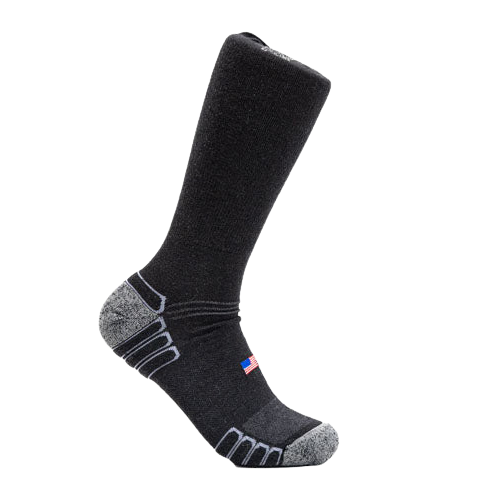Feeling that stinging pain in the back of your heel when you’ve still got four more hours left in your shift is no fun.
Every foreman has a few “old-man” tricks for how to avoid blisters from your boots, but some are downright outrageous.
As someone who’s suffered through a few blisters of my own, I’ve figured out a few easy hacks to prevent blisters on my feet.
#1 Wear Quality Wool Work Socks

Cotton socks absorb moisture and can lead to blisters.
Instead, opt for wool socks that wick away moisture. Wool allows better air circulation so that your feet don't sweat as much when they're trapped in a sweaty boot all day long.
Wool work socks from Camel City Mill are thermoregulated so your feet sweat (and stink) less, and cause less friction between your boot and skin, which helps prevent blisters.
#2 Get Tongue Pads
Tongue pads create a thicker tongue if your boots are too big and slip a little.
They help keep your feet firmly in place where they should be. Many times, tongue pads are thought to be used more in dress shoes, but there’s no reason not to use them in work boots too.
#3 Use a Shoe Stretcher
Break in your boots with a shoe stretcher.
This will help stretch out the leather and make them more comfortable to wear. If your boots are too tight of a fit, a shoe stretcher helps bring them up to the right size without you having to buy a brand new pair.
#4 Elevate Your Feet on Breaks
If you're working on your feet, take regular breaks and elevate your feet to give them a rest. This can help reduce swelling and prevent blisters from forming.
#5 Don’t Wear New Boots All Day

Don't wear a new pair of work boots for the first time all day.
Take them out for a walk around the block first, then try them on at home with some socks. This way you'll know if they fit correctly and won't give you blisters.
And when you do get a new pair of boots, bring your old beaters with you to the job site. A lot of guys I know will break in their new boots until lunch and then swap out for their old comfortable boots for the rest of the day so their puppies aren’t barking too loud.
#6 Install Work Boot Insoles
Buy a pair of insoles that are made specifically for work boots. These will help keep your feet from slipping and sliding inside your boots, plus they’ll add extra arch support, which can definitely help if you struggle with knee or lower back pain.
#7 Sprinkle on Cornstarch
Sweat causes friction. Which causes blisters.
When your feet start sweating, they can rub against the inside of your boot, which irritates the skin and can raise a blister. Cornstarch will reduce that friction (baby powder works too).
So if you start to feel too much rubbing in your feet, bust out the dust.
#8 Try Heavyweight Socks

Heavyweight socks will do even more to protect your feet from friction between layers while still absorbing moisture from sweating (if you wear socks made from synthetic or wool, not cotton).
Camel City Mill's Heavyweight Wool Work Sock has reinforcement on the heel and toe which offers a lot of abrasion resistance against blisters.
#9 Double-check Your Boot Size
Make sure your feet fit well in your boots. You should have about 1/4 inch of space between your longest toe and the end of the boot. Don’t just choose a boot size because you’ve always worn that size. If you think you’re a size 11 but are still getting blisters, you may be choosing the wrong size boot.
To make sure you’re getting the right size, go to the closest shoe store near you and use a Brannock device. It’s that metal contraption that always scared you as a kid. And write that number down, too.
It not only gives you the right length of your foot, but it’ll also give you the width. You may be wearing D-width boots, when you really need EE or wider.
Conclusion
Your heels will thank you if you follow these hacks to help prevent blisters from forming.
From getting a good pair of wool socks to sprinkling cornstarch on your feet, there are a few tried-and-true tricks you can use to keep your feet blister-free.






